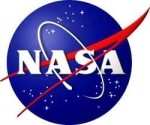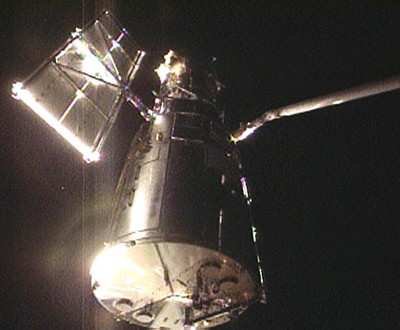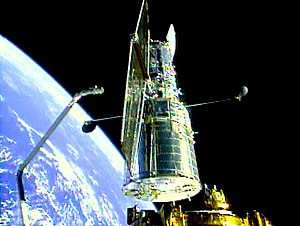Scientists Think It May Have Been Flung From The Galaxy By A
Black Hole
 NASA's Hubble Space Telescope has
detected a hypervelocity star, a rare phenomenon moving three times
faster than our sun.
NASA's Hubble Space Telescope has
detected a hypervelocity star, a rare phenomenon moving three times
faster than our sun.
The star may have been created in a cosmic misstep. A hundred
million years ago, a triple-star system was traveling through the
bustling center of our Milky Way galaxy when it wandered too close
to the galaxy's giant black hole. The black hole captured one of
the stars and hurled the other two out of the Milky Way. The two
outbound stars merged to form a super-hot blue star traveling at
incredible speeds.
This story may seem like science fiction, but Hubble astronomers
say it is the most likely scenario for the creation of a so-called
hypervelocity star, known as HE 0437-5439. It is one of the fastest
ever detected with a speed of 1.6 million mph. Hubble observations
confirm that the stellar speedster hails from the Milky Way's core,
settling some confusion about the star's original home.
Most of the roughly 16 known hypervelocity stars, all discovered
since 2005, are thought to be exiles from the heart of our galaxy.
But this Hubble result is the first direct observation linking such
a star to an origin in the center of the galaxy.
"Using Hubble, we can for the first time trace back to where the
star came from by measuring the star's direction of motion on the
sky," said astronomer Warren Brown of the Harvard-Smithsonian
Center for Astrophysics in Cambridge, MA. "Our measurements point
directly to the Milky Way center." Brown, a member of the
Hubble team that observed the star, is the lead author on a paper
about the finding published online July 20 in the Astrophysical
Journal Letters.
Brown said, "These exiled stars are rare in the Milky Way's
population of 100 billion stars. For every 100 million stars in the
galaxy, there lurks one hypervelocity star."
The stellar outcast already is cruising in the Milky Way's
distant outskirts about 200,000 light-years from the galaxy's
center. Using Hubble to measure the runaway star's direction and
determine the Milky Way's core as its starting point, Brown and
Gnedin's team calculated how fast the star had to have been ejected
to reach its current location. "Studying these stars could provide
more clues about the nature of some of the universe's unseen mass,
and it could help astronomers better understand how galaxies form,"
said team leader Oleg Gnedin of the University of Michigan in Ann
Arbor.

The star's age is another mystery. Based on the speed and
position of HE 0437-5439, the star would have to be 100 million
years old to have journeyed from the Milky Way's core. Yet its mass
-- nine times that of our sun-- and blue color mean that it should
have burned out after only 20 million years -- far shorter than the
transit time it took to get to its current location. Astronomers
have proposed two possibilities to solve the age problem. The star
either dipped into the Fountain of Youth by becoming a blue
straggler, or it was flung out of the Large Magellanic Cloud, a
neighboring galaxy.
In 2008 a team of astronomers thought they had solved the
mystery. They found a match between the exiled star's chemical
makeup and the characteristics of stars in the Large Magellanic
Cloud. The rogue star's position also is close to the neighboring
galaxy, only 65,000 light-years away. The new Hubble result,
however, settles the debate over the star's birthplace and places
it in the Milky Way.
The most likely explanation for the star's blue color and
extreme speed is that it was part of a triple-star system that was
involved in a gravitational billiards game with the galaxy's
monster black hole. This concept for imparting an escape velocity
on stars was first proposed in 1988. The theory predicted the Milky
Way's black hole should eject a star about once every 100,000
years.
The triple-star system contained a pair of closely orbiting
stars and a third outer member also gravitationally tied to the
group. The black hole pulled the outer star away from the tight
binary system. The doomed star's momentum was transferred to the
stellar twosome, boosting the duo to escape velocity from the
galaxy. As the pair rocketed away, they went on with normal stellar
evolution.
The more massive companion evolved more quickly, puffing up to
become a red giant. It enveloped its partner, and the two stars
spiraled together, merging into one superstar, the blue straggler
that Hubble observed. A blue straggler is a relatively young,
massive star produced by the merger of two lighter-weight
stars.
Astronomers used the sharp vision of Hubble's Advanced Camera
for Surveys to make two separate observations of the wayward star
3.5 years apart. Team member Jay Anderson of the Space Telescope
Science Institute in Baltimore developed a technique to measure the
star's position relative to each of 11 distant background galaxies.
These background galaxies form a reference frame in which Anderson
compared the star's position in 2006 and 2009 to calculate how far
it had moved.

"Hubble excels with this type of measurement," Anderson said.
"This observation would be challenging to do from the ground."
The team is trying to determine the homes of four other unbound
stars, all located on the fringes of the Milky Way. "We are
targeting massive "B" stars, like HE 0437-5439," said Brown, who
has discovered 14 of the 16 known hypervelocity stars. "These stars
shouldn't live long enough to live in the distant outskirts of the
Milky Way, so we shouldn't expect to find them there. But the
quantity of stars in the outer region is much less than in the
core, so we have a better chance of finding these unusual
objects."
 ANN's Daily Aero-Term (05.05.25): Circle To Runway (Runway Number)
ANN's Daily Aero-Term (05.05.25): Circle To Runway (Runway Number) ANN's Daily Aero-Linx (05.05.25)
ANN's Daily Aero-Linx (05.05.25) NTSB Prelim: De Havilland DHC-1
NTSB Prelim: De Havilland DHC-1 Classic Aero-TV: The Boeing Dreamliner -- Historic First Flight Coverage
Classic Aero-TV: The Boeing Dreamliner -- Historic First Flight Coverage Airborne-NextGen 05.06.25: AF Uncrewed Fighters, Drones v Planes, Joby Crew Test
Airborne-NextGen 05.06.25: AF Uncrewed Fighters, Drones v Planes, Joby Crew Test





